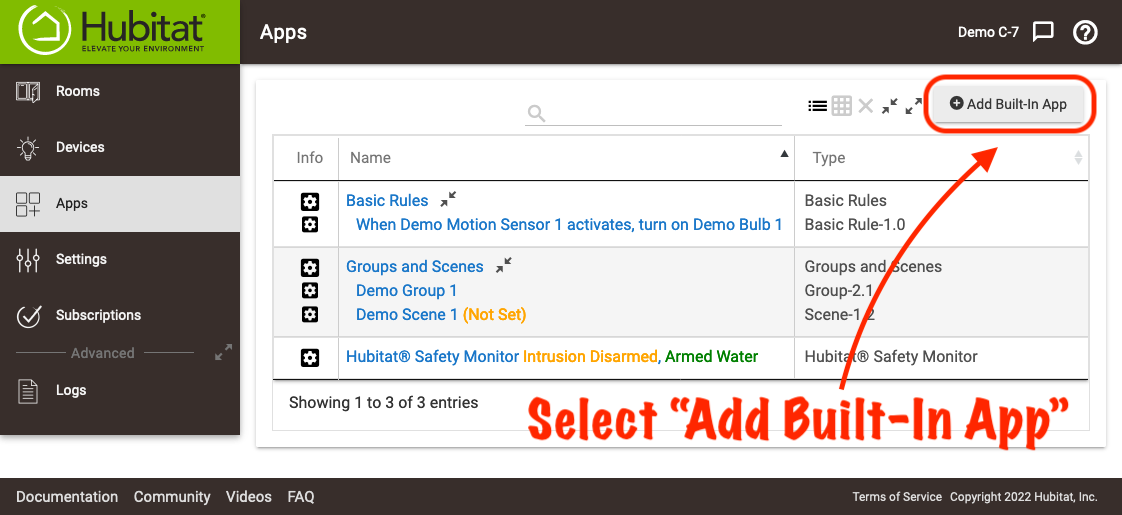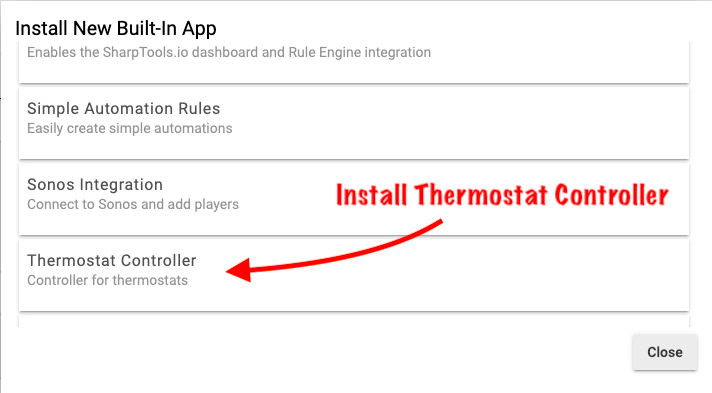Thermostat Controller
In many circumstances a properly located thermostat will work well to maintain comfortable temperatures. However, the performance of a heating and cooling system may suffer when the thermostat is not in the right location, or there is significant heat gain or loss in parts of the your home. Some thermostats also lack an Auto mode, which may result in difficulties during conditions that require both heating and cooling. The Thermostat Controller app allows more control of your connected thermostat by creating a virtual thermostat device to manipulate the set-points of the controlled thermostat, thus taking over most of its functionality and becoming the Controller thermostat for establishing set-points of your heating and cooling system.
Contents
Features
- Supports additional temperature sensors, allowing any connected device with temperature readings available to Hubitat Elevation®, to also participate as a remote sensor.
- Allows control of thermostat hysteresis to set the difference between the temperature at which the thermostat switches OFF, and the temperature at which it switches ON again.
- Auto mode is available to the Controller thermostat for conditions where both heating and cooling may be needed
- OFF function for when manually disabling the heating and cooling system is desired.
Additional Temperature Sensors
Improperly located thermostats are an all too common issue, but the powerful features in Thermostat Controller can help keep the temperature in your living space even by averaging multiple temperature sensors, rather than just using the sensor built into the thermostat. Many motion sensors and some door/windows sensors include temperature readings, that can be combined with the sensor in the thermostat, with the capability to offset a given sensor's readings, or place more or less weight toward the average from each sensor.
Control of Hysteresis
Hysteresis is the difference between the temperature at which a thermostat switches OFF, and the temperature at which it switches ON again. By carefully adjustment of the hysteresis value, the efficiency of the heating and cooling system can be optimized, ensuring maximum comfort in the conditioned space. With a lower hysteresis value, the system will cycle more frequently and the temperature swings in your living space will be lower. A wider hysteresis will result in the heating and cooling system cycling less frequently, thus resulting in correspondingly larger temperature swings. For example, with a default hysteresis value of 1.0 ˚F, and a thermostat setting to 75 °F, cooling will be called for when the temperature exceeds the 75 °F plus half of the hysteresis, or 75.5 °F. Once cooling begins. The system will remain ON until the average temperature has been reduced to 75 °F minus half the hysteresis value, or 74.5 °F.
Auto Mode Thermostat
Once the Thermostat Controller app takes control of a thermostat, its heating and cooling operation becomes automatic and will be dependent on the established setting for the controller thermostat. A heating and cooling system will typically move at least 3° F between ON and OFF cycles. For example, when the average temperature falls below the thermostat setting (less half the hysteresis), heating will be called for. Should the temperature rise above the heat setting (plus half the hysteresis), the system will return to idle. If the temperature continues to rise and reaches the cooling set-point (plus half the hysteresis), cooling would be called for.
If Auto Mode is not desired, and you only want the system to operate cooling or heating independently, simply adjust the set-point for the unwanted mode well out of a meaningful range.
WARNING! The Thermostat Controller app takes over control and most safeguards of the existing thermostat. Be sure to set the minimum and maximum values so that if the hub were to fail, the actual thermostat will not end up in a run-away condition.
Use with Thermostat Scheduler
To add scheduling for the Controller Thermostat, it may be selected in the Thermostat Scheduler app.
WARNING! Do not use the Thermostat Scheduler app directly on an actual thermostat that is already under the control of the Thermostat Controller app.
Thermostat Fan Mode
The Controller Thermostat created by the Thermostat Controller app will inherit fan modes from the actual thermostat. Fan speed adjustments made to either the actual or virtual thermostats will mirror each other.
NOTE: Thermostat fan mode may also be set on the Controller Thermostat by the Thermostat Scheduler app, which would then set it on the actual thermostat that the Thermostat Controller app is manipulating.
Installing Thermostat Controller
- From the Hubitat Web Interface select Apps
- Choose the Thermostat Controller from the list of Hubitat Elevation® Built-In Apps
Creating a Controller Thermostat
When you first set up Thermostat Controller, the controlled thermostat is not yet put under the control of the controller thermostat. The first section of the app UI shows the current setting of the controlled thermostat. These can be adjusted by opening that page. On that page is a setting called "Free/Controlled", and it starts out as Free. This means that the controlled thermostat is Free from being controlled. Only when you switch that selection to Controlled, does the actual control function of the app kick in.

